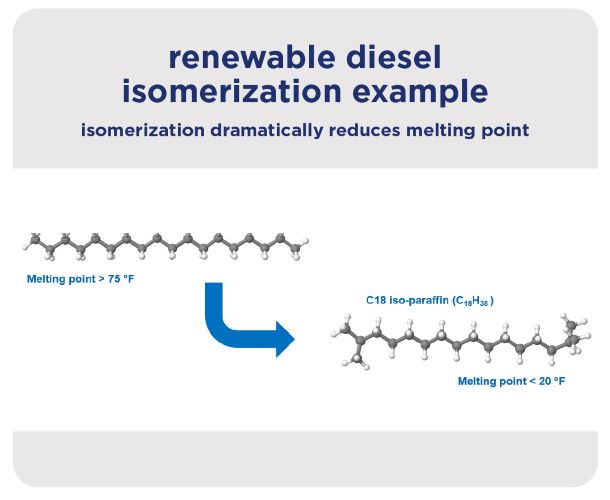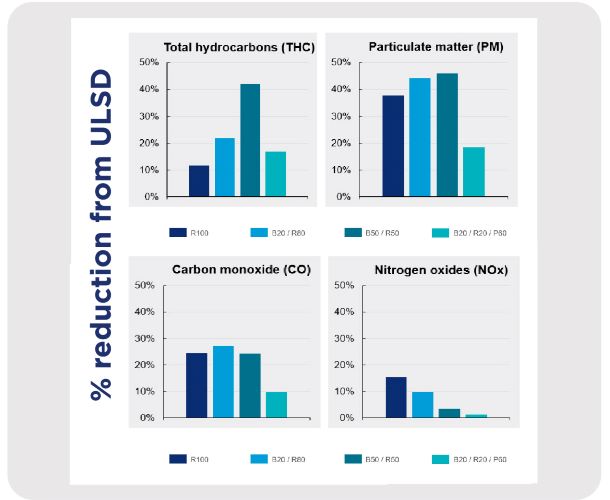Understanding Renewable Diesel
Overview:
• Renewable diesel is different from petroleum diesel, including its fungibility
• It’s important to pay attention to the cloud point of renewable diesel
• Consider blending in high-quality biodiesel to help with emissions reduction, lubricity and lowering the freezing point of the finished blend
As more renewable diesel fuel production comes online, understanding the source and capability of the fuel producer is important when you are making buying decisions.
Connect with one of our experts for more information
Connect
In 2019, two local producers and one international supplier provided renewable diesel in the US market.1 The quality of the renewable diesel fuel produced by those suppliers was almost identical. The cloud point was around -10C (+14F) year-round and the rest of the critical fuel properties were similar.2
Since then, additional renewable diesel producers have begun new production in the U.S. using varying technologies, catalyst systems and expertise. Today, renewable diesel properties including cloud point have a higher variance than what the industry experienced in 2019. In fact, there are only a few producers today that consistently meet a -10C cloud point limit year-round, and Chevron is one of those producers.
Learn More About Renewable Diesel
Isomerization is a key step
To make renewable diesel, the same types of feedstocks are used as when producing biodiesel. However, instead of reacting the fats, oils and greases (FOG) with methanol, as in the biodiesel production process, the FOG is first reacted with hydrogen to create “normal” paraffins, also known as n-paraffins. An n-paraffin is a straight-chain hydrocarbon that is solid at room temperature (just like candle wax). They need to be heated to become liquid and the melting point for that material is greater than 80 degrees Fahrenheit.

To lower the melting point, the n-paraffins must be isomerized to become iso-paraffins. The process takes the straight-chain n-paraffins and physically changes their structure so that they have side-chains called branches. Branching (isomerization) causes the melting point of those molecules to be dramatically lowered.
It’s not all it’s cracked up to be
Isomerization is an important step to create a fungible renewable diesel fuel. However, this process is not performed equally by all manufacturers because of the costs involved with this step. When it comes to isomerizing paraffins, the catalysts and the process technologies that can be used in isomerization may vary greatly in their efficacy, which can make it hard for some producers to achieve a desirable, low cloud point without cracking or breaking up the paraffins into smaller molecules outside of the diesel range. Cracking results in lower renewable diesel yield.
Chevron’s isomerization technology is excellent at preventing cracking, resulting in a lower cloud point product without a significant impact on renewable diesel yield.
Blending high-quality biodiesel can improve cold weather performance
Renewable diesel meets the same ASTM standard as petroleum diesel but can perform differently in cold weather. Renewable diesel can freeze solid when stored near its cloud point (e.g., -10C), unlike conventional diesel.
One strategy to avoid this problem is to use the Freezing Point test to determine appropriate temperature limits for storing and handling renewable fuels. Our research shows that the Freezing Point of renewable diesel (RD) can be reduced by including high-quality, low cloud point biodiesel (BD). This RD/BD blend is a 100% renewable fuel that can be stored, handled and used successfully at lower temperatures than renewable diesel alone.
Biodiesel/renewable diesel blends can provide consistent cold weather performance

UltraClean BlendTM is blended at various levels in this chart, including 20%, 50% and 80%.
In locations where daytime high temperatures are below freezing, there are benefits to including petroleum diesel in your renewable fuel blend. Adding petroleum diesel in the finished fuel may further help reduce the possibility of gelling issues and can aid cold temperature performance.
|
Renewable diesel is good fuel, but our biodiesel makes it even better. Download this fact sheet to learn more about this high-quality combination.
See Fact Sheet
|
Renewable fuel options with low cloud point
Renewable diesel is good fuel, but Chevron’s biodiesel makes it better. Renewable diesel may begin to freeze at temperatures higher than No. 2 petroleum diesel (ULSD) and form solid material that can clog vehicle fuel filters which may interfere with vehicle operations.
By including high-quality, low cloud point Chevron biodiesel in the renewable fuel blend, the fuel’s freezing point can be decreased to levels comparable to – or even better than – some ULSD fuels.
Chevron’s blend of 80% renewable diesel and 20% of our high-quality biodiesel is called UltraClean BlendTM. In addition to providing one of the lowest overall engine emissions of any diesel fuel, this fuel solution also offers superior cold weather performance.
Engine-out emissions reductions (CARB data)

These graphs show that as more biodiesel is blended, there is a dramatic reduction in both total hydrocarbon emissions and particulate matter emissions, which is beneficial for diesel particulate filter operation. Renewable diesel has a big advantage on NOx emissions.
Both fuels are good at reducing carbon monoxide emissions.
Questions about renewable diesel or RD/BD blends? Contact one of our experts.
Chevron Renewable Energy Group, Neste and Diamond Green
2 External testing reports